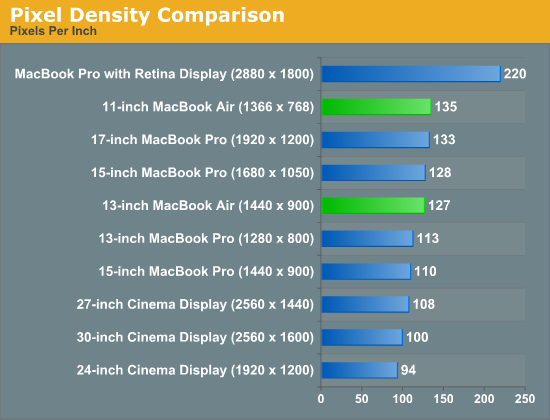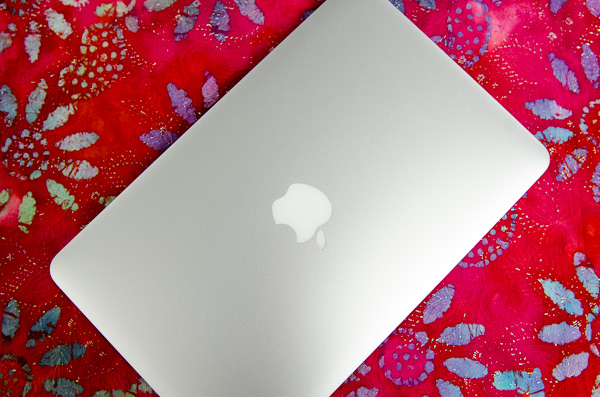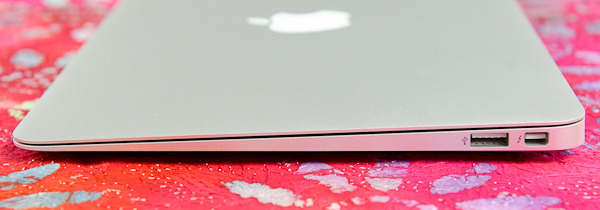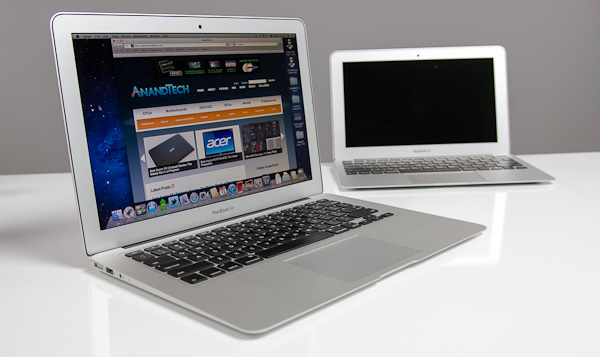The 2012 MacBook Air (11 & 13-inch) Review
by Anand Lal Shimpi on July 16, 2012 12:53 PM EST- Posted in
- Apple
- Mac
- MacBook Air
- Laptops
- Notebooks
Things are getting very blurry.
The MacBook Pro once stood for tons of power plus upgradability. Add a Retina Display and now it's just tons of power. It's a thicker, faster MacBook Air (with an awesome display). It's not bad, in fact it's quite amazing, but it confuses the general order of things.
The MacBook Air doesn't help in the clarity department. You can now order a MacBook Air with up to 8GB of RAM and a 512GB SSD, for the first time in MacBook Air history. Users who were once forced into Pro territory because of RAM and storage requirements can now happily live with an Air. And thanks to Turbo Boost, you do get similar performance in lightly threaded workloads.
Take a step away from the Mac world and you'll see the rest of the market is going through its own confusing period. Nearly every single Microsoft partner is mixing tablets and Ultrabooks. If your tablet uses smartphone hardware, and can dock into a notebook or Thunderbolt itself into a desktop, is all of this a lot of confusion before client computing moves entirely to smartphones? NVIDIA said it would happen publicly (even Intel did so privately a few years ago). Maybe it wasn't just convenient rhetoric. Maybe that's where we're headed. Until then, there are going to be a lot of different form factors, all with very compelling features. The MacBook Air continues to be one of them.
Despite the recent Ultrabook frenzy, the MacBook Air was one of the first (if not the first) to marry performance with usability, screen size/resolution, portability and battery life. Ultraportables prior to the MacBook Air's arrival in 2008 typically sacrificed in one or more of the above areas. I spent years in pursuit of the perfect ultraportable in college over a decade ago (30 is the new 20 right?), and generally came away disappointed and empty handed.
In 2010 Apple changed the expectations of cost with the MacBook Air. The new 11-inch model would start at just $999. And the 13-inch would only cost $300 more. The very first MacBook Air, by comparison, retailed for $1800. Apple took an ultraportable and made it its mainstream notebook. It was a bold move but one that was very forward looking.
Today the MacBook Air is even more affordable. The 11-inch model still starts at $999, but the 13-inch version is only $200 more. From the outside not a lot has changed, but that doesn't mean there's any less to talk about. Ivy Bridge, USB 3.0 and faster SSDs are all on the menu this year. Let's get to it.
The 11 & 13
Unlike the other thin member of Apple's Mac lineup, the MacBook Air chassis hasn't changed over the past three years. Since the 2010 update that gave us the 11-inch model and significantly lower prices, Apple has stuck with a design that only recently has seen widespread emulation.
While our last review focused on the beginning of a new generation, this review takes a look at a very mature, yet still very good design. The MacBook Air is just so pleasant to carry around. It'll make even the new rMBP feel like a pig.
Both the 11 and 13-inch models are effortless to carry around. While I dread traveling with a traditional notebook, slipping one of these into my backpack is barely noticeable. You can get used to and take for granted just about anything, but the form factor of the MacBook Air continues to be a favorite of mine even today.

The 11-inch MacBook Air is a great option for those who want the portability of a tablet but find themselves wanting to attach a keyboard to it most of the time. The 11.6-inch display boasts the highest pixel density of all of Apple's non-retina displays at 1366 x 768, but it's still quite usable. You don't make any sacrifices on keyboard size or key spacing (it's identical to the 13-inch model for the majority of the keys), nor do you have to give up any performance either. Apple offers all of the same CPU, memory and storage upgrades across both MacBook Airs. And with no discrete GPU, thermal throttling isn't really a problem either in the 11-inch chassis. With Thunderbolt, the 11-inch MacBook Air can actually give you the best of both worlds: an incredibly portable computer when you're on the go, and enough to act as your desktop when docked to a Thunderbolt Display.
I've traditionally always bought the 11-inch MacBook Air with the thought that I'd carry it when I didn't need to lug around my MacBook Pro. I seemed to be fooling myself however as over 90% of the time I'd end up with the MacBook Pro. The 11-inch Air was relegated to typewriter duty when I needed a change of scenery while writing at home. It's a great writer's companion, but if I couldn't have more than one system I'd have to opt for its bigger brother.
When I first reviewed the redesigned 13-inch MacBook Air I wrote that it felt more like a normal notebook, while the 11 was something a bit more unique. Perhaps I was more infatuated with the new 11 at the time, because these days I'm more drawn to the 13-inch MacBook Air as the notebook to have if you can only have one.
You get a 23.5% increase in screen resolution on a display that's just easier to look at. While 1440 x 900 is a bit much on a 15-inch MacBook Pro, I'd say it's near perfect on the 13-inch Air. If Apple were to do the Retina treatment on here, it'd be magnificent.
The larger chassis allows room for an SD card reader, which is thankfully quite functional. Otherwise the port layout is identical to the 11-inch model.
| 2012 MacBook Air Lineup | ||||||
| 11.6-inch | 11.6-inch (high-end) | 13.3-inch | 13.3-inch (high-end) | |||
| Dimensions |
H: 0.11-0.68" (0.3-1.7cm) W: 11.8" (30cm) D: 7.56" (19.2cm) |
H: 0.11-0.68" (0.3-1.7cm) W: 12.8" (32.5cm) D: 8.94" (22.7cm) |
||||
| Weight | 2.38 lbs (1.08kg) | 2.96 lbs (1.35kg) | ||||
| Cores/Threads | 1.7GHz dual-core Core i5 | 1.8GHz dual-core Core i5 | ||||
| Base Clock Speed | Intel HD 4000 | |||||
| RAM | 4GB DDR3L-1600 | |||||
| SSD | 64GB SSD | 128GB SSD | 128GB SSD | 256GB SSD | ||
| Display Resolution | 1366 x 768 | 1440 x 900 | ||||
| Ports | Thunderbolt, 2x USB 3.0, headphone jack | Thunderbolt, 2x USB 3.0, SD card slot, headphone jack | ||||
| Price | $999 | $1099 | $1199 | $1499 | ||
In its role as a proponent of simplicity, Apple has reduced the decision between what Air to get down to screen size, resolution and battery life (the 13-inch chassis houses a much larger battery). If you like having more of all of those things, the 13-inch Air is for you. If carrying anything larger than a tablet upsets you, buy the 11.




















190 Comments
View All Comments
EnzoFX - Monday, July 16, 2012 - link
but it's so cool to hate apple! Some people just can't stand when Apple has the overall better package. The thing I don't get with these haters is that they never, ever understand half the story. They get caught up in specs, they don't see that Apple consistently has solid drivers and software that other's solutions pale by comparison. Take touchpad drivers, they are still hit or miss, and not as good as Apple's Laptops. Those easy to get going apps? Well what do you think the average consumer wants? Actually, who doesn't want easy to set up? What good is an amazing camera if it has a cumbersome application to go with. I'm not saying one thing is more important than the other, just that it's all about the overall package, people like him clearly miss the more important components of it.Sunburn74 - Monday, July 16, 2012 - link
Its not hating apple. More like how an increasing number of reviewers walk in with pre-established beliefs concerning apple and those subconcious beliefs are evident in their writing. Its kind of like having a thing for blondes and then being a reviewer of good looks at a modeling contest. You can try your best to be perfectly objective, but geez your preferences will come out, especially to people who don't give a care about hair color or even more so to people who prefer brunettes and etc.Anand may not believe it (the people on engadget as well, and the verge is horribly pro apple), but he has pre-determinined beliefs about apple (like we all do) which come out in his writings. Just think about it like this. Anand's primary machines are macs. If he were to say mac's are crap, he'd be slighting himself in a way. I realize saying macs are crap are the extreme, but the point is the same. Saying something negative about apple is saying something negative about himself.
KPOM - Tuesday, July 17, 2012 - link
It's true the other way, though. Read the Macalope column in Macworld and you'll see examples of some of the nonsense put out (Katherine Noyes is a frequent target).Anand is pretty upfront that he uses Apple devices. However, he did point out the weak spot in the 2012 MacBook Air, which is that the display hasn't evolved along with the rest of the device. Otherwise, it's hard to argue with their choice of components. The keyboard and trackpad are still top notch (only now, about 4 years after Apple, are Windows OEMs starting to get multitouch trackpad drivers running smoothly, for instance). The SSDs are Samsung or SandForce based (in line with the industry). They are offering 256GB and 512GB SSD capacities (which are rare), an 8GB RAM option, and the 2.0GHz Core i7 option (many others are topping out at 4GB and the 1.7GHz or 1.9GHz i7). The camera and wi-fi components are competent. Objectively, it is difficult to argue that the MacBook Air isn't one of the higher end ultraportables.
mavere - Monday, July 16, 2012 - link
Anand states that the MBA is a top-tier competitor in the ultrabook market. Unless you care to refute that conclusion, the obvious implication is that Good >> Bad, which was the exact tone of the review.Five pages of bashing trivialities and concluding with "oh I guess this is one of the best products in its category" (not exactly a controversial statement here) would have served no one.
Freakie - Tuesday, July 17, 2012 - link
Yet other Anandtech writers do EXACTLY that. They will nit-pick over very many small "trivialities" but they will not go and use them to say that it is a crap product. There is a difference between objectively reviewing a product and then acknowledging its stance in the market, be it one of the best or one of the worst, and writing like a fanboy.Galatian - Monday, July 16, 2012 - link
On a side note I actually also did not see any improvement in camera to my MacBook Pro 15" from 2008 which was still the normal "SD" quality...then again I never used it for anything anyway...I just checked out: I do have the Samsung screen but Toshiba SSDs...The boot time IS amazing. Being able to work within 20s from pushing the button is invaluable to me, not that i got used to working my new Air.
By the way Anand: Am I just stupid or did you say you were going to post the screen profiles?
GotThumbs - Monday, July 16, 2012 - link
I totally agree.Objectivity and Independence is missing in this "Review".
Endorsement is more like it " buy the 11."
I've been Reading this site for over 9 years. Very disappointed with Anand.
uhuznaa - Monday, July 16, 2012 - link
Well, either Anand is mutating into an Apple fanboi or these things are really just good. Judging from the benchmarks and the pure facts (as well as my own limited experiences) I tend to the latter.[BTW, what's up with the login here? Neither Chrome nor Firefox are able to save and restore my password here. This really is getting on my nerves since I use strong, unique passwords everywhere and looking it up every fscking time I want to post a comment is somewhat uncomfortable.]
EnzoFX - Monday, July 16, 2012 - link
Works with 1Password =p.Anand Lal Shimpi - Monday, July 16, 2012 - link
The FaceTime HD camera in the MBA appears to be one of the best out there, at least in what I've seen compared to most notebooks. My point wasn't to balance out the negative, but rather put it in perspective. The comment about needing good lighting applies to every single integrated webcam shipping in a notebook today.The same for WiFi. The MBA's WiFi is competitive with everything else in its class, no one offers anything better in this chassis size while many offer something worse. Until recently many Ultrabooks were still shipping 1x1:1 configurations. The 3x3:3 setup is just something you get when going to the more expensive Pro models.
The real disappointment here is the display, not in that it's bad but that it's not as good as the new bar set by the ASUS Zenbook Prime.
Take care,
Anand